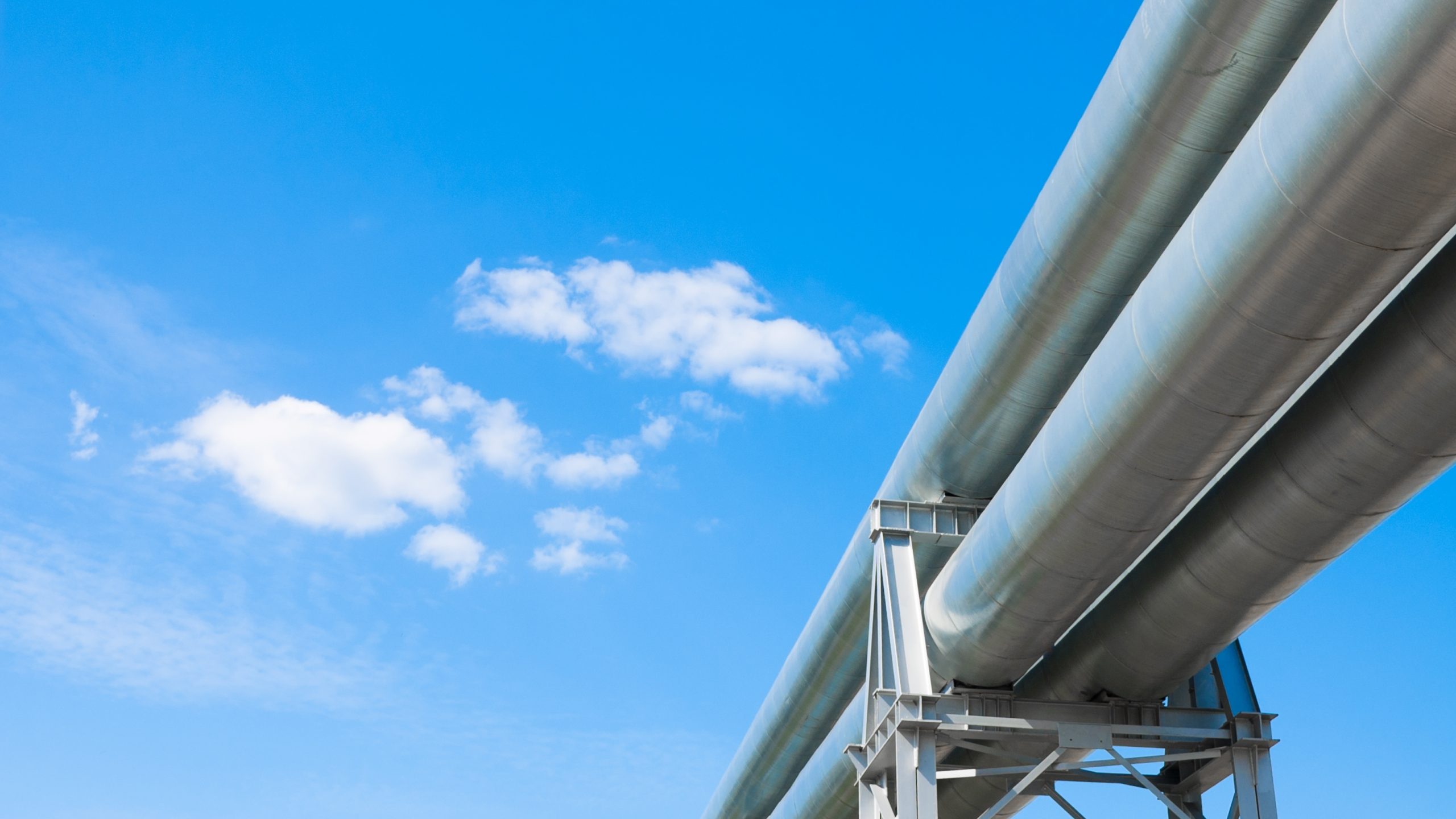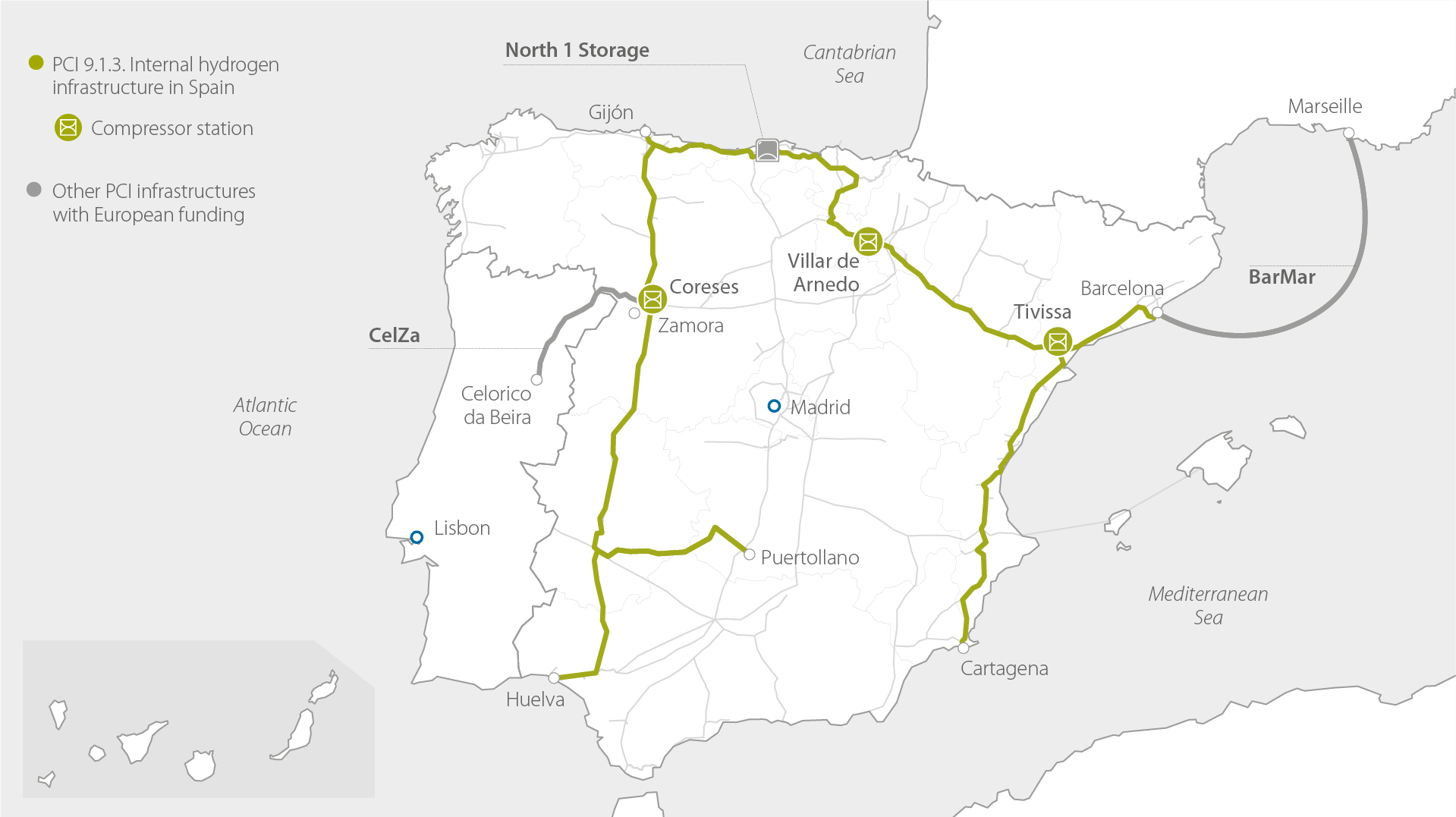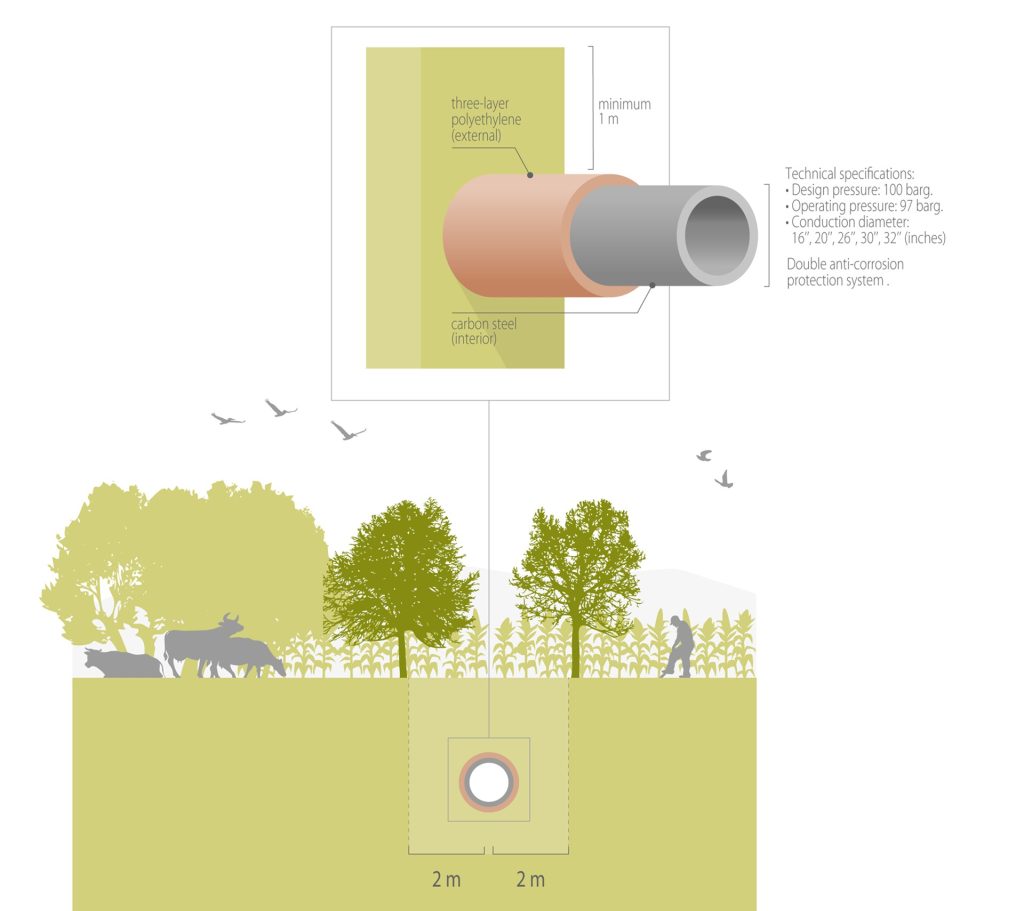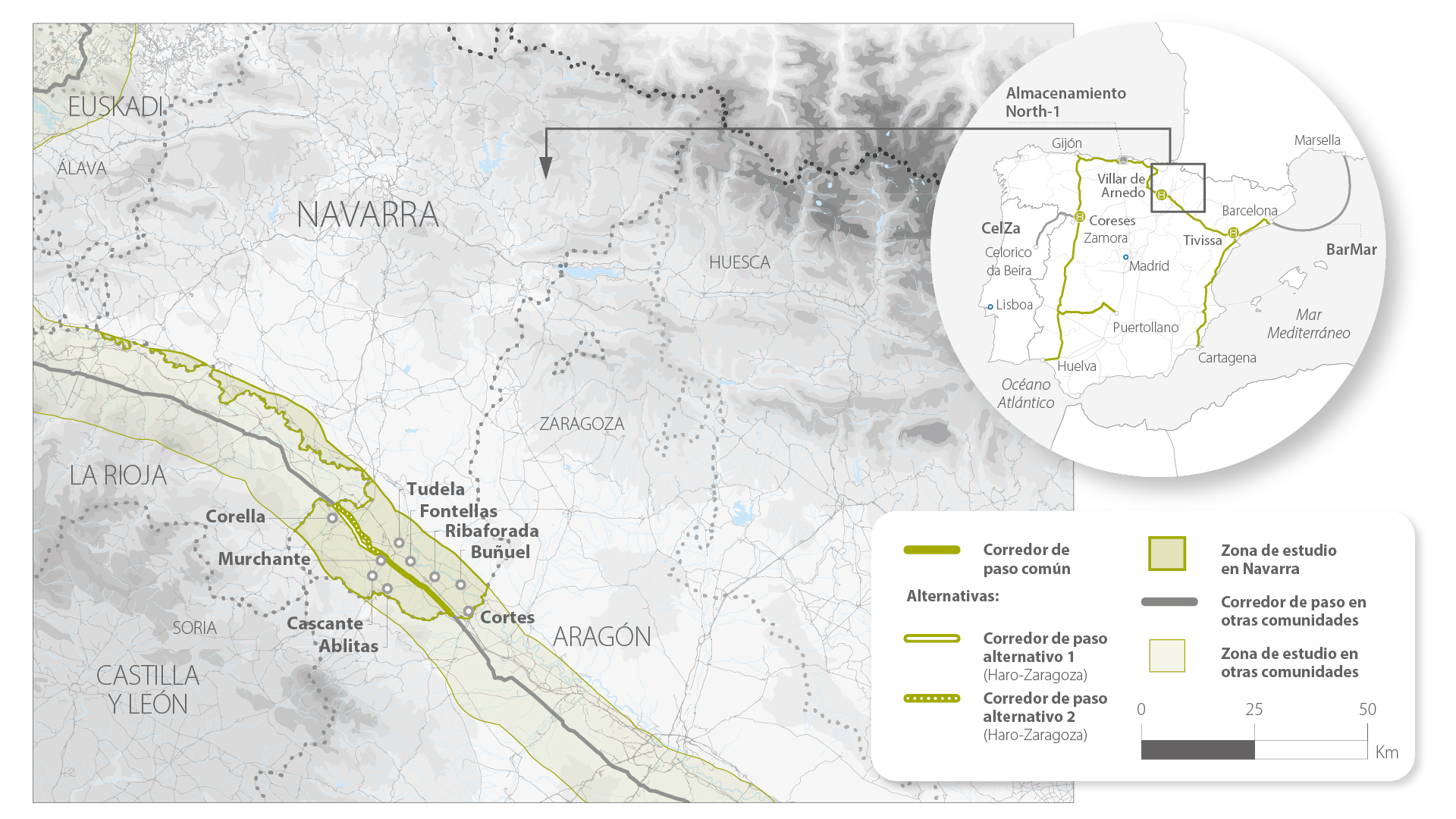
Internal hydrogen infrastructure in Spain
PCI 9.1.3. Internal hydrogen infrastructure in Spain
The project
Spain has a fundamental role to play and thanks to its renewable generation capacity, its geographical location, its technical and industrial capacity and its infrastructures and management experience, it has the opportunity to become the great green hydrogen hub of Europe.
Enagás Infraestructuras de Hidrógeno, following the mandate of the Ministry for Ecological Transition and the Demographic Challenge of July 2024, has initiated the development of the future hydrogen backbone network in Spain, recognised as a Project of Common European Interest (PCI 9.1.3.)
With the backing of the Spanish Government and the European Commission, and after being designated provisional Hydrogen Transmission Network Operator (HTNO) through Royal Decree-Law 8/2023 of 27 December, the company is promoting the first axes of this network for 2030.
Vía de la Plata Axis
≈ 875 km
Sections
Huelva-Mérida
Mérida-Salamanca
Salamanca-León
León-Llanera
Cantabric coast axis
≈ 440 km
Sections
Llanera-Reocín
Reocín-Arrigorriaga
Arrigorriaga-Haro
Ebro Valley Axis
≈ 535 km
Sections
Haro-Zaragoza
Zaragoza-Tivissa
Tivissa-Tarragona-P. BCN
Levante Axis
≈ 505 km
Sections
Tivissa-Salzadella
Salzadella-Paterna
Paterna-Agullent
Agullent-Cartagena
CLM Transversal Axis
≈ 235 km
Section
Almendralejo-Puertollano
5
AXIS
15
SECTIONS
≈2,600
km

In addition, in November 2024, Enagás also submitted four new sections of the Spanish network to the second call for hydrogen PCIs:
- Guitiriz-Zamora Axis
- Huelva-Algeciras Axis
- North Meseta Transversal Axis (Zamora-Navarra)
- South Meseta Transversal Axis (Puertollano-Madrid-Levante)
Their development, which contemplates around 1,480 additional kilometers of route and is planned from 2030, will allow all the peninsular autonomous communities to be connected to the hydrogen network.
Why a hydrogen backbone in Spain?
- It will cover Spain’s hydrogen needs, connecting the main renewable hydrogen production and consumption areas.
- It will allow surplus production to be exported to Europe, acting as a facilitator of the H2med corridor, which will connect the Iberian Peninsula with North Western Europe.
Technical development of the project
Transportation through a network of pipelines is the most efficient technology, from the economic, environmental and safety points of view, to transport green hydrogen from the points of production to the points of consumption.
The project of the first axes of Spain’s internal hydrogen network consists of the development of 15 underground pipeline sections, new or reconverted, grouped in 5 axes. It also includes surface facilities: compression stations and valve positions.
Hydrogen pipelines
The design of the hydrogen pipelines will be based on the international standards for this type of infrastructure, the applicable legislation in force in the industrial sector, and in accordance with the regulations and complementary technical instructions currently in force in Spain.
It will have all the technical safety and supervision systems to guarantee its safe operation.
Valve positions
Preliminary studies for the project estimate about 110 newly constructed valve positions to be located about 20-30 km from each other on the same line as the pipeline route.
They will be equipped with remote actuation and control systems, as well as permanent monitoring and permanent monitoring systems to ensure safe operation.
For each of the valve positions an external low-voltage power supply is required from a nearby point.

Compressor stations
It is an installation that increases the hydrogen pressure in order to transport it over long distances between different territories through the pipeline.
Preliminary studies for the project estimate about three compressor stations located in Coreses (Zamora), Tivissa (Tarragona) and Villar de Arnedo (La Rioja).
These are fenced facilities with an estimated surface area of less than 50,000 m2 each, the exact location of which will depend on the technical, environmental and social conditions, taking into account the existence of other Enagás connections in the vicinity.
A high-voltage power line will be required to supply electricity for its operation.
A European-funded project
In January 2025, the European Climate, Infrastructure and Environment Executive Agency (CINEA) granted 100% of the Connecting Europe Facility (CEF) Energy funds requested by Enagás for the study phase of these first axes of the hydrogen network. Funding of €32.5 million.
Visit the European Commission’s Transparency Platform here.

Positive impact on the territory
The development of the hydrogen backbone will have a significant positive impact on the Spanish economy and on the territory.

A more sustainable energy future
The network will be key to the decarbonisation of industry and heavy transport

Technological and industrial development
Creation of a hydrogen industry and generation of innovative business fabric in Spain

Growth and competitiveness
€3.31 Bn gross investment (year 2024-2030)

Job creation and revitalization of territories
17,200 new jobs during the construction of the network and 900 jobs in the operation and maintenance phases
The hydrogen economy in Spain will generate more than €32 Bn of GDP and will maintain some 81,000 jobs each year during its development
*Source: Report “Socioeconomic impact of the development of the hydrogen economy in Spain”, prepared by PWC for Enagás (2023)
Commitment to environmental and social sustainability
Green hydrogen is a 100% renewable vector essential for combating climate change and for the energy transition. The hydrogen network development project will have a very low environmental impact thanks to the implementation of preventive and corrective measures at all stages.
From planning to restoration, a balance between technological development and environmental preservation is ensured.
The new network will run
≈ 80%
along the existing gas infrastructure route
Reuse
21%
of current pipelines
Industry’s interest in a national hydrogen network
In the last quarter of 2023 Enagás carried out a non-binding Call for Interest to determine the real potential of the renewable hydrogen market in Spain and confirm its proposal for the development of the hydrogen infrastructure for 2030.
This open and transparent consultation had great participation, with 206 companies and 650 projects submitted, and identified hydrogen production by 2030 of around 2.5 million tonnes per year (Mt/y), and a demand of around 1 Mt/y.
The results of the process concluded that the expected supply and consumption confirm the design of these hydrogen transport and storage infrastructures, which were later confirmed by the European Commission as PCIs.
Internal Hydrogen Infrastructure in Spain Project Brochure
06/05/2025
Internal Hydrogen Infrastructure
Internal Hydrogen Infrastructure in Spain non-technical summary
06/05/2025
Internal Hydrogen Infrastructure
Castilla-La Mancha general map
24/04/2025
Castilla-La Mancha
Internal Hydrogen Infrastructure
Extremadura detail map
24/04/2025
Extremadura
Internal Hydrogen Infrastructure
Extremadura general map
24/04/2025
Extremadura
Internal Hydrogen Infrastructure
*The maps are indicative and are subject to change according to engineering developments and future administrative and environmental processing of the project.

A hydrogen infrastructure
backbone for Spain
Find out more about this European Project of Common Interest boosted by Enagás and the development of its public participation process.
Internal Hydrogen Infrastructure in Spain Project Brochure
06/05/2025
Internal Hydrogen Infrastructure
Internal Hydrogen Infrastructure in Spain non-technical summary
06/05/2025
Internal Hydrogen Infrastructure
Castilla-La Mancha general map
24/04/2025
Castilla-La Mancha
Internal Hydrogen Infrastructure
Extremadura detail map
24/04/2025
Extremadura
Internal Hydrogen Infrastructure
Extremadura general map
24/04/2025
Extremadura
Internal Hydrogen Infrastructure
What is green hydrogen and why is it important?
Green hydrogen is a clean energy vector that does not generate polluting emissions -since it is produced from renewable energies through a water electrolysis process- and is versatile. It is therefore the perfect ally for the decarbonization of many key sectors of the economy, especially those for which electrification is not a viable solution, such as intensive industry or heavy transport.
Green hydrogen is a key element in speeding up the energy transition process towards zero net emissions. An essential vector to achieve the objectives of decarbonization, security of supply and energy sovereignty defined by the European Union in its REPowerEU plan, and by the Government of Spain in its National Energy and Climate Plan (PNIEC).
Why is a hydrogen infrastructure network needed in Spain?
The results of the non-binding market consultation (Call For Interest) that Enagás carried out at the end of 2023 show that there is a geographical dispersion between the production and consumption of green hydrogen expected in our country and in Europe. Therefore, a hydrogen infrastructure network is needed to connect supply and demand.
A pipeline network is the most efficient alternative to transport green hydrogen and make it accessible to multiple consumers, contributing to energy sovereignty and the competitive decarbonization of Spain.
Developing a hydrogen infrastructure network is essential for Spain to take advantage of the enormous opportunity to be the great European reference in the production and export of green hydrogen, thanks to its privileged geographical position, great renewable potential, industrial and technological capabilities, and its solid network of energy infrastructures.
What will be the uses of the green hydrogen transported through this infrastructure?
The renewable hydrogen transported by the Spanish backbone network will be used to replace the existing demand for gray hydrogen, natural gas and the consumption of other fossil fuels in industrial processes and the transport sector, fundamentally.
Green hydrogen will have a significant impact on those industrial sectors that are difficult to electrify, such as the oil refining, chemical (mainly fertilizers) and metallurgical sectors. It is also expected to have applications in other industries such as ceramics, glass and cement.
Renewable hydrogen will also play a very important role in the decarbonization of road mobility -especially heavy transport-, aviation and the maritime sector, due to its difficult electrification. Transport will have to increase year by year the consumption of renewable fuels of non-biological origin (RFNBO): mainly hydrogen and derivatives, in order to comply with European regulations.
Which are the benefits of this new infrastructure network for Spain?
Spain’s future hydrogen infrastructure network has significant benefits:
- Climate action: this project is key in Spain’s decarbonization process and will help reduce carbon emissions, which is essential to curb climate change. It will also contribute to achieving the goal of having a 100% renewable energy system by 2050.
- Key energy for Spanish industry: access to an indigenous, safe, 100% renewable energy vector for the competitive decarbonization of our industrial fabric.
- Positive economic impact: the hydrogen network will have a tractor effect on various economic sectors. Together with the H2med corridor, it is estimated that its construction will have an impact on GDP estimated at 4,706 million euros. Its operation will bring in an additional €115 million annually.
- Job creation: the construction of the hydrogen network will create approximately 17,000 jobs. In addition, its operation and maintenance will help maintain another 900 jobs each year.
What impact will the project have on the environment?
Environmental protection is a key priority at all stages of the project. An initial identification and evaluation of potential environmental impacts has been carried out at a general level and preventive and corrective measures have been defined to minimize them.x
The environmental impact of the project is mainly concentrated on the construction activities necessary for the development of the infrastructures and its magnitude will depend on the environmental characteristics of each of the environments in which the project is developed. In any case, the effects will be recoverable once the works are completed, with the restitution and revegetation of the affected land.
Environmental monitoring will be carried out during the execution of the project to ensure that the measures are effective and that the established environmental standards are met.
More information here.
What is the planned schedule for the project and what stage of development is it at?
During the year 2024, the necessary studies have been carried out to complete the conceptual engineering of the project and, at present, the basic engineering works are being developed that will allow the design of the facilities that make up the project to be finalized.
At the same time, the documentation and deployment process of the Public Participation Conceptual Plan (PCPP) is being developed. This is a requirement established in the European regulation for the so-called Projects of Common Interest (PCI), with the aim of identifying from an early stage the sensitivities and concerns about the project in the territory where the infrastructure would be implemented. The deployment of this public participation process will be carried out from April 2025 and is expected to be completed in October 2026. More information here.
According to the schedule established in the project planning, it is estimated that the hydrogen backbone will be completed and commissioned in 2030.
Is green hydrogen safe? What risks does it cause to the people?
Green hydrogen is considered safe for the population if it is handled correctly and proper safety measures are implemented. It is not toxic to humans or wildlife and is not corrosive to materials. However, it is flammable, so it must be handled, stored and used with caution and applying the most stringent safety procedures and standards to minimize and keep under control the possible risks associated with its handling.
The design and construction of the hydrogen network will take into account the highest international design, operation and maintenance standards. Systems will be used to guarantee the integrity of the facilities and anticipate possible anomalies, based on continuous monitoring of cathodic protection and periodic inspection for early detection of any deviations. Remote control and isolation systems will also be used to isolate a section of pipeline that could be affected by an incident.
Where will the hydrogen produced in Spain be consumed?
Spain has the potential to produce the most competitive renewable hydrogen in Europe, which, in the first place, will serve to cover the needs of the national industry, transporting the hydrogen through the Spanish backbone network. In addition, this network will also contribute to the development of the H2med project, promoted by Spain, Portugal, France and Germany. The H2med corridor will allow the surplus national production to be sent to Europe and has an export capacity of up to 2 million tons of renewable hydrogen per year, equivalent to 20% of the hydrogen production expected in 2030 in the EU, according to REPowerEU.
Public participation
As a PCI project of the European Commission, Enagás will carry out a Public Participation Concept Plan (PCPP) for the Spanish hydrogen network starting in April 2025 and lasting 18 months.
In this process, and in accordance with the provisions of the European Union Regulation No 869/2022 of the European Parliament and of the Council of 30 May 2022, the company will make the characteristics and basic information of the project available to all interested parties, involving local councils and other public administrations, associations and citizens and gathering their contributions.
What are the objectives?
- Transparent reporting: share clear information about the future hydrogen network with all stakeholders.
- Overcoming doubts and explaining the need and benefits of the project.
- Engaging the community: encourage their active participation in the process.
- Identifying and mitigating impacts: anticipate and ensure that the most appropriate measures are in place to address them.
- Improve project acceptance: taking into account environmental sensitivity and social legitimacy at an early stage.
The largest public participation process of its kind ever carried out in Spain
The deployment of this Public Participation Plan throughout Spain will be carried out in a consecutive and staggered manner in the different autonomous communities.
13
autonomous communities
25
provinces
+550
municipalities
+50
national authorities
≈380
organizations and associations
What does it involve?
These are some of the main informative and participative actions that Enagás will carry out in this process:

Website

Informative brochure
See it here.

Workshops with experts

Participatory meetings with citizens and Administration

Information points (fixed and mobile)
Do you have any doubts?
Request information about the project or send us any questions you may have
Information on meetings and informations points at Navarra
02/12/2025
Navarra
Internal Hydrogen Infrastructure
Information on meetings and informations points at Euskadi
07/11/2025
País Vasco
Internal Hydrogen Infrastructure
Information on meetings and informations points at Principality of Asturias
24/10/2025
Asturias
Internal Hydrogen Infrastructure
Information on meetings and informations points at Castile Leon
07/10/2025
Internal Hydrogen Infrastructure
Information on meetings and informations points at Cantabria
09/07/2025
Cantabria
Internal Hydrogen Infrastructure
The territorial deployment of the PCPP will be synchronised with the development of the engineering studies in order to meet the project schedule and maximise public participation.
The implementation of the Public Participation Plan for each Autonomous Community and the corresponding sections of the network is expected to take three to four months, at the end of which a final report on the results of the process will be drawn up.

On April 25, Enagás will present this PCPP at an institutional event at the National Hydrogen Center in Puertollano (Castilla-La Mancha).
Coming soon in…
La Rioja
Information on meetings and informations points at Navarra
02/12/2025
Navarra
Internal Hydrogen Infrastructure
Information on meetings and informations points at Euskadi
07/11/2025
País Vasco
Internal Hydrogen Infrastructure
Information on meetings and informations points at Principality of Asturias
24/10/2025
Asturias
Internal Hydrogen Infrastructure
Information on meetings and informations points at Castile Leon
07/10/2025
Internal Hydrogen Infrastructure
Information on meetings and informations points at Cantabria
09/07/2025
Cantabria
Internal Hydrogen Infrastructure

Communication
Keep updated on all the news about the project and its public participation process.
Contact
Internal hydrogen infrastructure

(+34) 685 669 191
Monday to Friday from 9 AM to 2 PM
